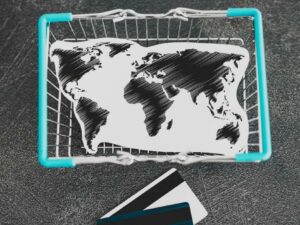
As late as the 17th century, London bankers organised payments through payment receipts; an idea reflected on modern Pound banknotes with the sentence “I promise to pay the bearer on demand the sum of….”
Even after paper currency became the global standard, many nations used printed bills to represent the owners’ held value in gold. The ‘gold standard’ remained the basis for the international monetary system until 1971, when the US forbade foreign central banks to exchange USD for gold.
Currencies have come in all weird and wonderful shapes throughout history. Here’s a list of 10 of the strangest substitutes for cash used as legal payment across the world.
1. Germany – Notgeld wooden blocks
Germany’s Post-WW1 government, the Weimar Republic, was plagued by an extended period of social discontent, violence and hyperinflation.
During the war, the German government rapidly printed new money to pay for guns and ammunition. However, after the war concluded, there was more money in circulation than goods to buy. The resulting hyperinflation forced businesses to pay workers twice daily, as their morning wages devalued so quickly that their money became virtually worthless by the afternoon.
Local townships took measures into their own hands. They instead traded using Notgeld (meaning ‘necessity money’, issued in a time of economic crisis). Notgeld was printed on everything from aluminium foil to playing cards, but most commonly on wooden blocks.
When the Reichsbank recovered, international collectors quickly snapped up the rare currency and returned hard cash in its place, a huge help to German households.
2. Zaire – Holey francs
The African nation of Zaire, known today as the Democratic Republic of the Congo (DRC), has a tumultuous history of civil strife, military regimes and armed coups.
When rebels overthrew Joseph Mobutu’s dictatorship in 1997, the new government didn’t have the time, personnel or resources to print new notes.
Its simple solution was to continue using existing currency with one rather strange correction – the government only considered notes in circulation to be legal tender if the likeness of former president Mobutu were cut out.
The DRC used the Zaire Franc for several more years before new notes were designed and printed to replace them.
3. Micronesia – Rai stones
Rai stones were used as currency on the island of Yap in what is now the Federated States of Micronesia.
Rai stones were circular disks carved from limestone with a hole punched through the middle. To the people of the Island of Yap, limestone was rare and displayed as a symbol of social prestige and wealth.
While some Rai stones could fit in the palm of your hand, others were as big as 12 feet in diameter and weighed up to 8 tons. Interestingly, the stones did not need to move physically to transfer ownership. Larger stones were simply left in place.
4. Cameroon – Bottle caps
In 2005, a Cameroonian brewery launched an ambitious advertising campaign where customers could win expensive prizes by redeeming barcodes stamped on bottle caps.
The venture was a roaring success, and other companies soon followed suit. A sales war ensued and prizes became almost guaranteed to help promote further sales. Bottle caps quickly became pseudo-legal tender and created a gambling economy where the chance to enter the prize pool was used to purchase everything from haircuts and taxi rides, much like trading lottery tickets.
5. Italy – Parmigiano-Reggiano cheese
Credem, an Italian regional bank, holds almost half a million wheels of Parmigiano-Reggiano cheese in a high-security complex surrounded by barbed wire.
By holding produce as a substitute for cash, the bank helps simplify expensive financial operations for local dairy farmers in Northern Italy. It’s the only place that can make ‘real’ Parmesan, much like how ‘real’ Champagne can only be produced by the Champagne region of France.
Credem also offers loans using cheese as collateral. It stores and ages the wheels in climate-controlled vaults for the duration of the loan. As it ages, the cheese gains value, helping farmers pay back some of the money borrowed.
6. Australia – Plastic money
Australia was the first country to introduce plastic polymer banknotes in 1988. The notes were designed in collaboration between Australian Scientist David Solomon and the Reserve Bank of Australia.
Some countries such as Canada, Vietnam and the UK have since adopted polymer currencies as they are more durable and harder to counterfeit.
The Australian Dollar continues to lead the way in banknote security measures. AUD bills now include multiple unique identifiers, including fluorescent ink and printed textures. More recent denominations also include 3D images which move as you tilt the note.
7. Zimbabwe – 100 trillion Dollar note
Zimbabwe is the only country in history to have the dubious honour of making every citizen a trillionaire.
Following a total economic collapse in the early 2000s, the country’s currency experienced hyperinflation likened to that of the post-WW1 German Reichsmark.
The Zimbabwean government’s response was to redenominate the currency and simply remove zeros to make computations more manageable. They did this not once, but three times – in 2005, 2008 and 2009. Each time, hyperinflation quickly replaced the zeros removed, and old bills were soon put back into circulation.
The largest bill ever minted was the Z$100 trillion note, reported to be worth just a few US Dollar cents. This figure is subject to debate, as at the time, the Zimbabwean Dollar was suffering from an inflation rate of 79,600,000,000% at its peak.
8. Ancient China – Flying cash
‘Chinese Flying Money’, or ‘Fei Qian’, holds an important place in history as the predecessor of all paper currency.
Invented by merchants during China’s Tang dynasty, flying cash helped merchants move large sums of money across the country, replacing heavy copper and gold coins which were difficult to transport.
The Chinese Emperor Yang Yen cemented the use of flying cash in Chinese commerce after tax reforms permitted the payment of taxes in money rather than crops or material goods.
9. Chile – the ‘Chiie’ Peso
In 2008, Chile accidentally printed an estimated 1.5 million 50 peso coins with ‘Chiie’ rather than Chile on the front. The coins were worth £0.06 each, equating to a £90,000 mistake.
Nearly a year went by before anyone noticed the problem as the error was overlooked throughout the entire production and approval chain.
The coins officially retain their face value. However, collectors highly value them and will pay substantially more to obtain them.
10. Space – ‘Teflon’ QUID
The Quasi Universal Intergalactic Denomination (QUID) was developed in a partnership between the National Space Centre and the University of Leicester.
The QUID derives its name from the British slang for money and is designed to withstand extreme environments using a space-qualified polymer called polytetrafluoroethylene (PTFE), better known as ‘Teflon.’ The QUID’s material and round shape makes it easy to store and transport without damaging spacecraft.
Each denomination is based on one of the eight planets in the solar system and marked to prevent counterfeits. While not technically legal currency, anyone can purchase QUID through a handful of authorised vendors.
Matthew Swaile
Copywriter
Florence Couëdel
Editor









